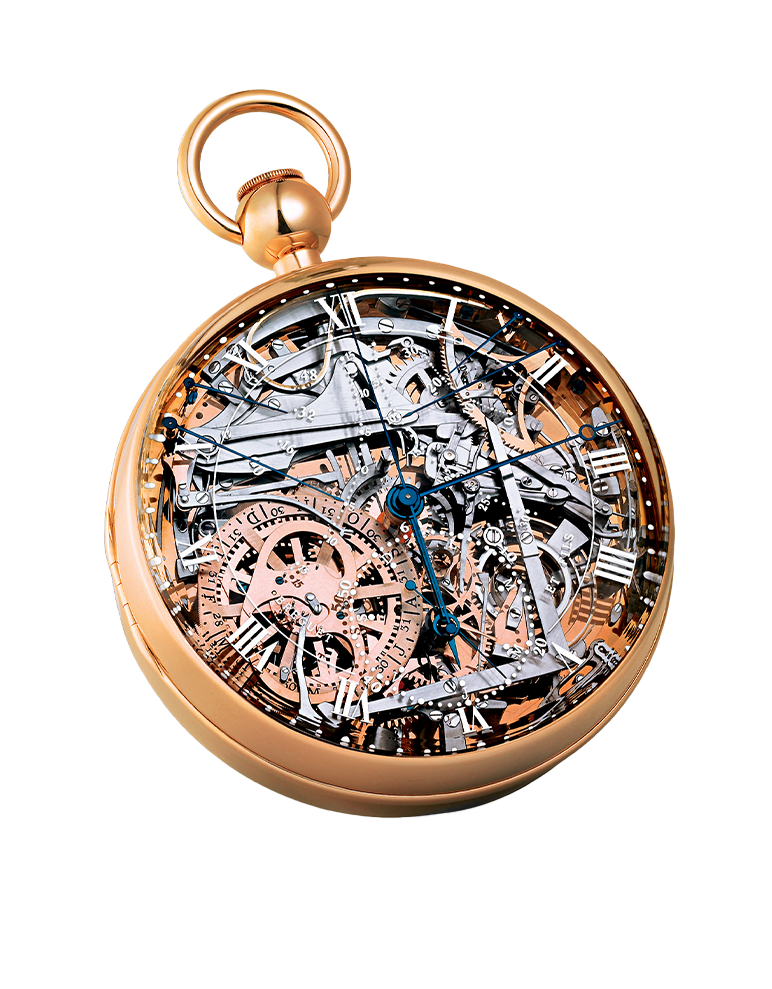Presentation of the “Marie-Antoinette” watch in a re-edition version
It took the Breguet watchmakers three years of intensive work to recreate the N°160 watch identically.
“Grande Complication” pocket watch number 1160
Said to have been fascinated by Breguet’s watches, Marie-Antoinette acquired over the years a number of his timepieces, notably a perpétuelle fitted with a self-winding device. In 1783, a mysterious admirer of hers ordered from Breguet, as a gift for the Queen, a watch that was to be as spectacular as possible, incorporating the fullest range of horological expertise known at the time. The order stipulated that wherever possible gold should replace other metals and that auxiliary mechanisms, i.e. complications, should be as numerous and varied as possible. No time or financial limits were imposed.
Long a purveyor to the French court, Breguet thus had a free hand. Alas, the Queen never got to admire her present, watch number 160, known as the “Marie-Antoinette” in her honor. It was only finished in 1827, 34 years after her death, 4 years after Breguet’s and 44 years after he’d accepted the order.
For two centuries now, both this timepiece’s extreme intricacy and its fabulous destiny have fascinated watchmakers and haunted the imagination of collectors. Stolen in 1983 from a museum in Jerusalem and finally recovered in December 2007, this undisputed masterpiece of horology experienced a fate so mysterious and bizarre that it became something of an obsession. In 2004, Nicolas G. Hayek challenged Breguet’s watchmakers to build an exact replica of this breathtaking pocket watch.
Recreating so many complications solely with the help of ancient documents proved a real challenge for the firm’s technicians and watchmakers. The original technical drawings in the Breguet Museum archives and the material available in such rich sources of cultural information as the Musée des Arts et Métiers, both in Paris, provided the only available information and guidance regarding the watch’s every function and styling detail. Comparing the projected watch with contemporary timepieces, in particularly the Duc de Praslin’s watch, revealed novel aspects of the design and workshop techniques of the period. The research uncovered skills which had partly disappeared, enabling Breguet to produce a timepiece faithful in every way to its fabled ancestor.


A work of art in its own right, the new Marie-Antoinette perpétuelle, or self-winding, watch features a minute repeater that on command strikes hours, quarters and minutes as well as a full perpetual calendar showing the date, the day and the month at two, six and eight o’clock respectively. At ten o’clock, an equation-of-time display expresses the difference between civil and solar time. At centre, jumping hours and a minute hand accompany a large independent seconds hand, the forerunner to the chronograph hand, while a subdial for the running seconds is situated at six o’clock. A 48-hour power-reserve indicator and a bimetallic thermometer are positioned side by side.
The watch’s self-winding movement ( called perpétuelle in Breguet’s day ) comprises 823 parts and components, all finished with exceptional care. Plates, bridges and bars, every moving part of the motion-work, calendar and repeater mechanisms are made of wood-polished pink gold. Screws are of blued and polished steel. All friction points, sinks and bearings are fitted with sapphires. The watch’s sophisticated design extends to its special escapement with natural lift, a cylindrical balance spring in gold and a bimetallic balance. A double pare-chute shock-protection device protects the balance-wheel staff and the oscillating weight arbors against blows and jarring.
In April 2008, after four long years of research and reconstruction, the new Marie-Antoinette timepiece was proudly placed in its impressive presentation case, carved from the wood of the very Versailles oak tree under which the Queen once used to rest.
Following a long dry spell and a violent storm, the Domaine de Versailles had to have the once-mighty oak cut down, presenting its wood to Nicolas G. Hayek as a birthday gift.